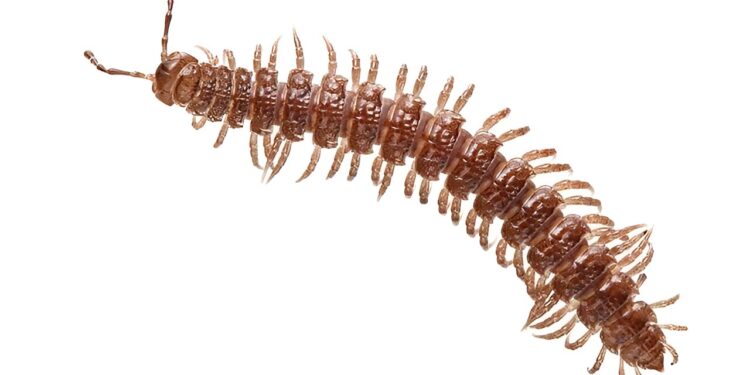Soil organisms can live anywhere, from the surface to much deeper, from millipedes like Polydesmus to insects and microbes. Credit: The Trustees of the Natural History Museum, London and Harry Taylor
Earthworms, insects and mites are all threatened by soil pollution, and scientists are concerned that we know very little about the damage it causes.
New research published in the journal iScience Scientists have discovered that soil pollution is the main cause of the decline of organisms living underground. This discovery surprised scientists, who had expected that agricultural intensification and climate change would have much more significant consequences.
Dr Victoria Burton, co-author of the new study conducted at the Natural History Museum, said the findings were “concerning”.
“The biggest impacts on biodiversity are related to land use, climate change and invasive species, so we assumed the situation would be similar underground,” says Victoria. “However, our results show that this is not the case.”
“Instead, we found that pollution from pesticides and heavy metals caused the most damage to soil biodiversity. This is worrying because there hasn’t been much research into the impacts of soil pollution, so its effects may be more widespread than we think.”
“As concerns about soil degradation grow, we need to consider the impacts that other sources of pollution, such as microplastics, hydrocarbons and persistent chemicals, have on the life beneath our feet.”
The secret life of soils
Compared to life on the surface, life in soils is relatively unknown. In fact, in addition to the difficulty of finding the organisms that live there, the soil is actually made up of several superimposed habitats.
“Soil is not just a homogenous pile of dirt,” Victoria explains. “It’s a complex environment that contains many different structures, nutrients and minerals. While most life is found within 10 centimetres of the surface, some organisms can live much deeper.”
“But with so few specialists able to identify underground organisms, we know much less about life below ground than we do on the surface.”
This means that when it comes to determining how soil communities are doing, many questions remain open. While habitat destruction and persecution are known to be among the greatest impacts on aboveground biodiversity, only a few studies have attempted to address their belowground counterparts.
To try to account for this phenomenon in their new research, the team conducted what’s called a meta-analysis. In this case, scientists take data from many existing studies and reanalyze them to answer new questions that the original research didn’t address.
For this meta-analysis, Victoria and the rest of her team reused data from more than 600 studies, including thousands of different data points, to see what impact humans were having on soil health globally.
In-depth soil research
According to their results, above- and below-ground fauna generally react very differently to the same problems.
While the loss of an above-ground forest can be devastating for the plants and animals that live there, researchers’ predictions that below-ground organisms would also be affected have not panned out. Instead, it appears that the soil has acted as a buffer, helping its organisms be more resilient to certain changes.
“Soils can store moisture and nutrients, which can help underground life withstand changes, at least in the short term,” Victoria says. “For example, while climate change is increasingly affecting species above ground, its effects below ground appear limited for now.”
“However, the long-term effect of these impacts is less well known, meaning that this buffering effect may only provide temporary relief to soil communities.”
While most changes, such as rising temperatures or chemical pollution, have had negative effects on soil biodiversity, some have been positive. The most important has been the use of organic fertilizers and mulches, which introduce more carbon into the soil. This is particularly beneficial for earthworms, which feed on the nutrients and recycle them back into the soil.
While this study has shed light on changes affecting soils, it is still in its early stages. The team hopes that future research will focus on how interactions between factors such as climate change and pollution might strengthen or limit their joint impacts.
They also hope to get more people interested in soils. Victoria wants to inspire the next generation of researchers while working with students as part of the National Education Nature Park, run by the Natural History Museum.
“I’m excited to be integrating soil biodiversity work into the National Nature Education Park,” says Victoria. “It’s a great opportunity to get young people interested in the life beneath their feet and to engage them with the life cycles of animals like crane flies and beetles that they may not know about.”
“It’s not only an opportunity to inspire them, but also to do important scientific work that is currently neglected.”
More information:
Helen RP Phillips et al., Global changes and their environmental stressors have a significant impact on soil biodiversity — A meta-analysis, iScience (2024). DOI: 10.1016/j.isci.2024.110540
Provided by the Natural History Museum
This article is republished with kind permission from the Natural History Museum. Read the original article here.
Quote:Soil pollution surpasses climate change as main threat to underground biodiversity, study finds (2024, September 4) retrieved September 4, 2024 from
This document is subject to copyright. Apart from any fair dealing for the purpose of private study or research, no part may be reproduced without written permission. The content is provided for informational purposes only.



